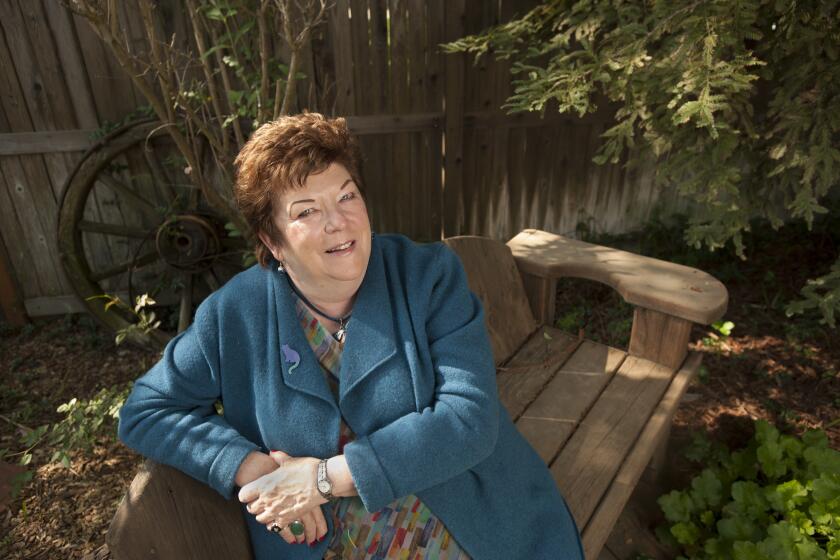Calculator Issue : Math Class: Old Ways Don’t Add Up
Here’s the problem: “The 130 children at the Marie Curie School are going on a picnic. Each school bus can hold 50 passengers. How many buses will be needed to take all the students?”
Only one-third of the sixth-graders in California’s schools gave the obviously correct answer--three. Instead, most said the answer was “2 and 3/5” or “2 with a remainder of 30.”
“The first thing students do with a problem is get a pencil and start computing. That’s what school emphasizes,” said Tej Pandey, a testing official in the California Department of Education. “So it never occurs to them that you can’t have a fraction of a bus.”
For a growing number of mathematics teachers, this small problem and the children’s reaction to it illustrates the odd mismatch between how math is taught and how it is used today.
Solving Problems
For adults, whether in business, universities or sitting around the dinner table at bill-paying time, the principal purpose of math is to solve problems. Simple ones are done in the head, and detailed computations are performed on a calculator. For students in the middle and upper grades, however, math classes consist mostly of doing computations by paper and pencil.
“We spend 95% of our time having them practice something that won’t be used outside of school,” said Clyde Corcoran, a Whittier High School math teacher who chaired a statewide panel seeking to redirect the math curriculum.
Typically, students do not grapple with more challenging math problems that require thinking, not just computing. At the same time, they often miss out on learning such practical skills as how to use statistics or how to mentally estimate an answer.
“We do spend a lot of time working on long division, which is ridiculous,” said Marian Pasternack, a math teacher at the Sherman Oaks Center for Enriched Studies, a Los Angeles magnet school.
Pushing for Change
These math teachers and others like them are pushing hard to shift how math is taught--away from paper-and-pencil computations and toward solving more complex problems, possibly aided by calculators or computers. And this summer, they plan to make their voices heard as the California State Board of Education begins its review of the new math textbooks to be used in the state’s public schools over the next seven years.
Theirs is neither the abstract “new math” approach of the 1960s nor a “back-to-basics” push from the 1970s. Rather, they say they want to bring mathematics teaching into line with a world of computers and calculators.
The effort is being watched closely by many mathematicians who believe that the math curriculum is archaic. Because California is one of the few states to select textbooks on a statewide basis--and is the largest buyer of them--the outcome of this debate is expected to influence mathematics teaching across the nation.
“The traditional curriculum in the middle grades was designed for a nation of small shopkeepers,” said Henry O. Pollak, a mathematician for Bell Communications Research who headed a National Science Foundation panel on school mathematics. Yet, for shopkeepers as well as almost everyone else, the nearly universal use of calculators and computers has changed what they do.
“The calculator has made some subjects more important and some less so,” Pollak said in an interview. For example, being able to estimate has become more important. “The best defense against a silly mistake is to know how the answer should look before you begin,” he said. A student should realize, for example, that multiplying 19 x 22 is close to 20 x 20, so the answer should be close to 400.
“It is also important that citizens can look at data, analyze it and draw conclusions from it. We don’t teach much of that,” he said. “Instead, we spend an enormous amount of time doing paper-and-pencil arithmetic.”
Urge Calculators
Pollak’s panel, in a 1983 report to the National Science Foundation on “What Is Fundamental” in mathematics, urged schools to introduce calculators into the math classrooms “at the earliest grade practicable.” Moreover, the panel said, “substantially more emphasis should be placed on (teaching) mental arithmetic, estimation and approximation, and that substantially less be placed on paper-and-pencil execution of arithmetic operations.”
The just-published California Mathematics Framework, the guide for choosing the state’s new textbooks, adopts the same basic view.
“The California framework is terrific. If they put this into effect, California will lead the nation in changing how mathematics is taught,” Pollak said.
Since hand-held calculators first came into broad use in the early 1970s, many teachers and parents have viewed them as a threat. If a tiny computing machine is available as a crutch, how will students learn basic arithmetic?
But for more than decade, university researchers have studied pupils who have used calculators and have found no dire consequences--and some significant benefits.
Positive Effect
“The clear indication of the research is that the calculators have a positive effect on achievement,” said Marilyn Suydam, an Ohio State University professor of mathematics education who headed a federally funded center on calculators and learning.
Of 175 studies comparing classrooms where calculators were used with those where they weren’t, “less than 2% showed a somewhat negative effect on achievement,” she said. In about half the studies, the students who had used calculators in class scored higher on math tests. (Neither group of children was allowed to use calculators on the tests.) In the rest of the studies, there was no significant difference in the rate of learning between the two groups, she said.
“It is important to remember we’re not talking about an ‘either-or’ situation. The children still must learn the basic facts in their head, and they continue to do most two-digit computations on paper,” Suydam said.
The studies also turned up a less surprising finding: Relieved of the tedium of doing long computations on paper, students in the calculator classes reported that they liked math more.
UCLA mathematics Professor James Caballero noted that most new inventions have aroused a similar fear.
“It is often said that the invention of papyrus caused fear that memories would dry up because people could write everything down, or that, during the Reformation, books would allow people to read others’ thoughts and therefore, not learn to think for themselves,” he said.
There are some math teachers who believe just that.
The 40,000-member National Council of Teachers of Mathematics has strongly endorsed the use of calculators in the classroom, but in April, its annual meeting in Washington was the scene of one of the odder demonstrations in the nation’s capital. Decked out in a navy blazer and a straw boater, John Saxon, a conservative publisher of his own math texts, led 20 teachers carrying protest signs outside the convention hotel. They read: “The Button’s Nothin’ ‘Til the Brain’s Trained” and “Beware: Premature Calculator Usage May Be Harmful to Your Children’s Education.”
Quick to Agree
But the advocates of using calculators in schools were quick to agree with Saxon’s point that students need to learn basic arithmetic on their own.
“The calculator is a tool for someone who already knows basic arithmetic,” Suydam said.
Although calculators have been slow to work their way into the classroom, math professors say the main obstacle is no longer teachers. Instead, they blame the textbooks and tests, both of which continue to stress the traditional paper-and-pencil exercises.
“For most teachers, the textbook determines what they do in class,” UCLA’s Caballero said. “We’re hoping this new framework (the state guidelines) will cause someone to generate some new and better texts. A lot of us are optimistic that something really significant will happen this time.”
Last year, the state board rejected the pending series of science textbooks, insisting that the works be revised to include more material on controversial topics such as evolution and human reproduction.
Expects Similar Fight
State Superintendent of Public Instruction Bill Honig said that he expects a similar fight on mathematics books.
“We want math books that are more challenging--just better books--which is exactly what we fought for in science,” Honig said. “We have some big holes in our (math) curriculum now. We need to teach computation, but we also need more work on problem-solving, geometry, measurement and statistics.”
A team of mathematics teachers and professors will review the new series of math texts over the summer and make their recommendations to the state board in the fall.
“We’ve set forth the guidelines on what we want, and we’re going to stick to them,” Honig said.
To go along with a change in textbooks, the state Department of Education is working on a change in its tests. Teachers have complained that standardized exams in math focus almost exclusively on computation.
‘Reasonable Answer’
As a result, the mind-set for students is “get a pencil and start computing, regardless of what the problem says. We want them to think first about what is a reasonable answer,” said Pandey, the state testing official who is working on a redesign of the state’s 8th- and 12th-grade exams.
State officials believe that they can get across that message with a simple stroke. Beginning in December, 1987, 12th-graders will be permitted to use hand-held calculators on the math portion of the California Assessment Program tests.
The test designers are busy putting together new questions, some of which are more complex problems while others will challenge the student’s ability to mentally calculate the best answer.
The mathematicians and state officials hope that new textbooks and redesigned tests will convince even the reluctant teachers that it is time to change the way math is taught.
“The kids basically learn what we teach them, and what we’ve been concentrating on is routine drills in computation,” said Corcoran, the veteran Whittier teacher. “But we’ve totally ignored what’s been going on outside the schools. Our curriculum is outdated, and we’re turning out students who are not prepared for a world of computers and calculators.”
“In education, it seems to take decades to change anything,” he concluded. “I just hope we’re going to make it this time.”
NEW CALIFORNIA MATH QUESTIONS
For new editions of the California Assessment Program mathematics tests, state education officials are formulating new questions that are intended to require students to think about a problem and estimate which answer is correct. Here are a few examples from trial tests last year:
1. The number 50 is divided by a number between 1 and 2. The answer is a number between
(a) 1/50 and 1/25
(b) .5 and 1
(c) 1 and 25
(d) 25 and 50
(e) 50 and 100
2. In a certain city, the price of gasoline has varied between $1.06 and $1.48 per gallon over the past year. During that period, which of the following purchases could have been made with a $10 bill without receiving any change back?
(a) 5.1 gallons
(b) 5.8 gallons
(c) 8.7 gallons
(d) 10.2 gallons
(e) 12.7 gallons
3. Ryan took four tests in class. The sum of his four test scores was 120. What MUST be true about Ryan’s scores?
(a) All of his test scores are 30.
(b) Ryan scored 60 on at least one test.
(c) Ryan did not score 100 on any test.
(d) Ryan scored less than 40 on at
least one test.
(e) Ryan did not fail any of his tests.
ANSWERS: 1. (d) Only 42% of the 8th-graders answered this question correctly in the trial test.
2. (c) “This is a 12th-grade question. We would hope they would see that if the gasoline were just more than one dollar, they could get just under 10 gallons, and if it were about $1.50, they could get about 7 gallons. So the only answer is between 7 and 10,” said Tej Pandey, a state testing official.
3. (d) Only 34% of the 6th-graders answered this correctly.
More to Read
Start your day right
Sign up for Essential California for news, features and recommendations from the L.A. Times and beyond in your inbox six days a week.
You may occasionally receive promotional content from the Los Angeles Times.







